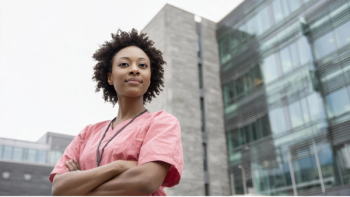
Nurses Discuss COVID-19's Impact on Cancer Care
Cancer care may never be the same again after the COVID-19 pandemic. In a recent webinar, 2 oncology nurses discussed their experiences.
Constant change seems to be the new normal for nurses across the country who are treating patients with cancer during the coronavirus disease 2019 (COVID-19) pandemic. To-date, the United States has over 800,000 cases of the disease, with nearly 49,000 deaths.
“Everything changes daily; you just don’t know what you’re coming in to,” said Amber S. Norton, RN, BSN, OCN, an oncology nurse at the West Cancer Center and Research Institute.
“It was really frustrating for a lot of people at the beginning of all the closures to know what was the best practice to follow,” Kelly A. Rone, APN, an advanced practice nurse at the Mayo Clinic said. “That seems to hav settled down as things have progressed. But there’s this underlying fear of, ‘Do I have it? Does the patient I’m caring for have it?’… Patients used to think that whatever symptom they’re having was related to cancer. Now things have shifted and they think whatever symptom they’re having is related to COVID.”
Norton and Rone recently participated in an Oncology Nursing News/OncLive webinar to discuss how the COVID-19 health crisis has affected their day-to-day lives in the clinic.
Personal Protective Equipment
The highly contagious coronavirus has caused an increased use — and a subsequent shortage – of personal protective equipment (PPE) for healthcare providers, particularly when it comes to N95 respirators. Last month, the Oncology Nursing Society (ONS) came out with
“We’ve been fortunate that we haven’t had to experience that,” Norton said, noting that outside organizations have donated PPE. “We use N95s for the people who are testing the patients or exposed to possible cases. Otherwise, we’ve been doing the standard handwashing, social distancing, sanitizing before you go in [patients’ rooms].”
Norton also mentioned that all staff members are now wearing masks, as well.
Rone also said that her institution has been fortunate, but the COVID-19 outbreak has caused her and her colleagues to conserve materials more. For example, many surgical kits contain a mask that would usually be thrown out.
“They really implemented reusing things that we would have never reused before, so it’s a really interesting process to see,” Rone said.
Telehealth in Cancer Care
In addition to increased protections in the clinic, there has also been a push to keep people out of healthcare institutions as much as possible.
“Mayo was focused on how to get more people staying home,” Rone said.
Clinicians nationwide have been implementing telehealth as a way to see their patients without putting them — and the providers – at an increased risk of being infected. And while the nurses said that this is a learning curve for both the treatment team and the patients, telehealth is here to stay.
“Getting some of our patients to understand how to manage the video calls and even have the ability to do so has been a challenge. But it’s really worked out well,” Norton said. “I think that telehealth and telemedicine is a great advancement for patients… Patients can continue working — they can [have an appointment] on their lunch break!”
Rone, who also mentioned that many patients at the Mayo Clinic have long commutes or drive from out of state, agreed. “It’s very beneficial to our patients.”
Newsletter
Knowledge is power. Don’t miss the most recent breakthroughs in cancer care.
























































































